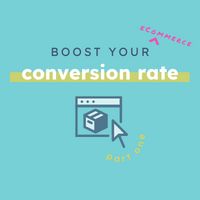An effective way to maximise the profitability of your ecommerce website is to increase the percentage of website traffic that your store converts to buyers.
In other words, optimise your ecommerce conversion rate.
Benefits of Conversion Rate Optimisation
In essence, conversion rate optimisation is the data-driven process of improving the buyer journey on your ecommerce website to increase the likelihood of each visitor making a purchase. No prizes for guessing that the primary benefit is increased revenue. But it’s worth noting that optimising your ecommerce website for conversions can boost your marketing in other areas.
As monoliths like Google and Facebook become more obsessed with user experience, their algorithms reward websites that put the customer first with more impressions. So if you’re looking to improve your SEO and paid ads performance, optimising your website for user experience could pay huge dividends beyond simply improving your ecommerce conversion rate.
Do you Need to Hire an Agency for Conversion Rate Optimisation?
Not necessarily. Conversion rate optimisation (CRO) needn’t be complicated, difficult or expensive. If you’re equipped with a willingness to engage data in your decision making, and the ability to put yourself in your customer’s shoes, you can be reasonably confident that the time and resources you invest will eventually pay off. However, hiring an agency can save you time and money. Without the learning curve, an experienced ecommerce marketing agency can get you results faster.
Over the next four articles, you’ll learn to apply a step-by-step process we use here at Studioworx to increase our customers’ conversion rates.
In this first article, we’ll unpack some key concepts and explore benchmarks and goal setting to get you started on your conversion rate optimisation.
What is a Conversion in eCommerce?
An ecommerce conversion is when a website visitor buys one of your products.
There are other steps in the buyer journey that can be defined as a conversion, like opting in for an email list, getting a promo code, or adding a product to a wish list. Avoid getting into the weeds with preliminary steps in the buyer journey. These actions are in service of your ultimate goal of selling more products, so it’s important to be clear at the outset exactly which actions directly result in a revenue increase.
What is eCommerce Conversion Rate?
The degree of success you have in converting website visitors into buyers is your conversion rate.
It’s your number of sales expressed as a percentage of visitors over a set period of time.
How do you Find Your Conversion Rate?
Consult your Google Analytics for data on site visitors and conversions.
Google Analytics has a bunch of other stats that will help with your conversion rate optimisation – we’ll dig into this rich data source when we take you through the CRO Audit. At this stage, you’re simply establishing what your ecommerce conversion rate is and understanding what that number means.
So now you’ve got your conversion rate. The next step is to interpret it.
What is the Average eCommerce Conversion Rate?
If your ecommerce conversion rate is sitting between 1% and 2% then you’re bang on global average – most web stores won’t convert more than 2 visitors out of every hundred.
Average conversion rates differ slightly by vertical and location, so it’s a good idea to research your industry for more strategic benchmarking.
What is an Acceptable eCommerce Conversion Rate?
In an increasingly competitive ecommerce landscape, ‘average’ won’t cut it. We’d urge you to set your sights on a conversion rate that’s aspirational but achievable in your vertical.
For our clients here at Studioworx, we aim to achieve a minimum ecommerce conversion rate of 5% which we achieve with CRO combined with other marketing services. If you’d like us to take a look at your website and get your conversion rate to Studioworx levels, please get in touch. We’d love to chat!
How Do You Improve Your Ecommerce Conversion Rate?
If your conversion rate isn’t at the level you want it to be, don’t panic. A higher conversion rate could be achievable with some changes to the buyer experience on your website.
In the next article, we’ll help you identify sources of friction for the site visitor and create a plan to systematically implement strategic improvements to the user experience (UX).
Don’t miss Part 2! Sign up to get the next instalment of our ecommerce conversion tips delivered to your mailbox.
